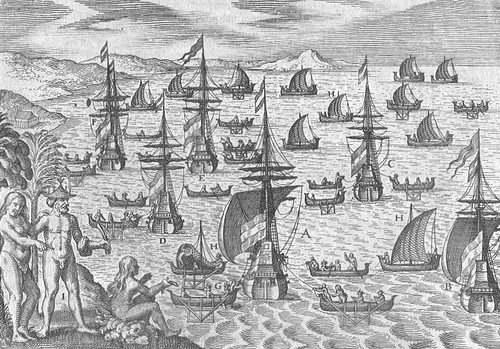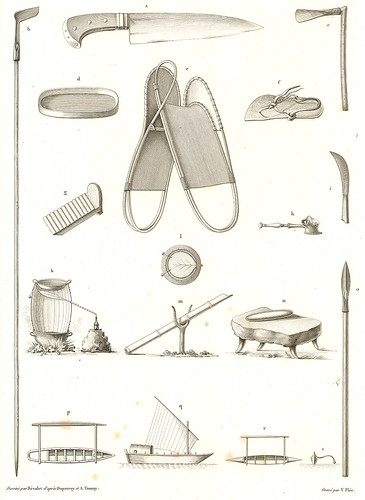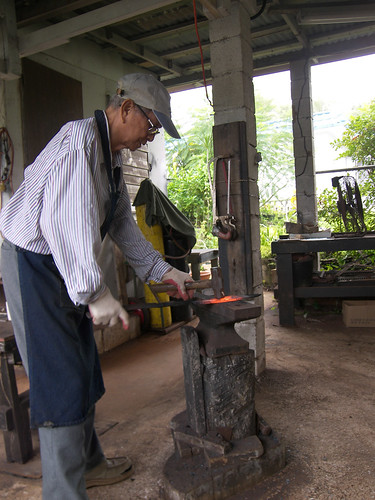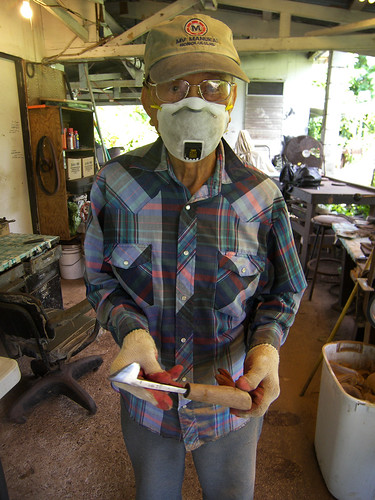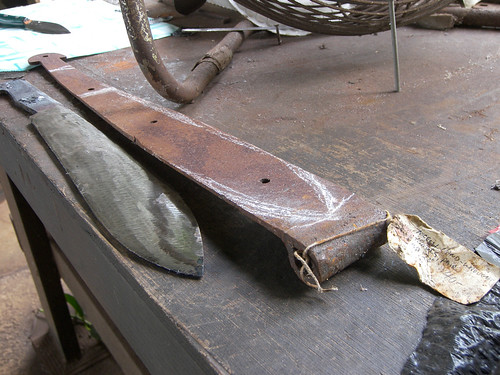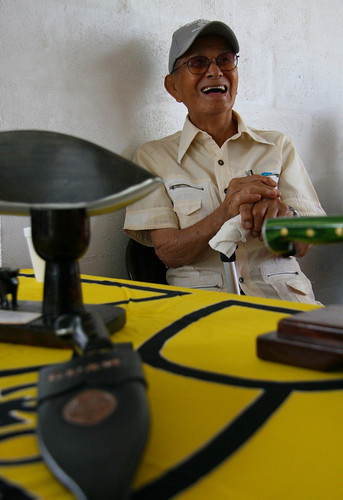Blacksmithing
Herreron CHamoru
Blacksmithing, in the form that it is most known today, has only existed on Guam for a few centuries. On the surface blacksmithing on Guam might appear to be something which was introduced by the Spanish. In reality however, the origins of CHamoru blacksmithing are much more complex and has its roots in indigenous technologies prior to colonization by the Spanish and the desire of CHamorus to adapt to new introductions and innovations.
The role of the herreron CHamoru, or CHamoru blacksmith in the life of CHamorus, making the tools to support their lifestyle, reached its apex during the pre-war period of Guam’s history, but has in the time since all but disappeared from Guam.
Ancient Guam Era
CHamoru society, prior to the arrival of Europeans in the 16th century, was supported through the farming of staple vegetables such as suni (taro) and fa’i (rice), and depending upon your social caste, either fishing in the tåsi (ocean) or fishing in the island’s inland streams. CHamorus made tools from shell, to’lang (bone), håyu (wood), åcho’ (stone) and guafi (fire) in order to make tools to suit these needs and others including, the building of structures and defense.
The bones of humans, in particular the shin bone, would be taken after someone had long been dead and carved to make spear tips or se’se (knives). Stone would be used to create lusong (grinding stone) for food and medical preparation, or sharpened to make the heads of higam (axes). Wood was used to make topong (handles) and longer pieces were fashioned into damang (swords) or implements for picking fruit, planting and weeding (dagua). Shells would be carved to making weaving tools (si’i) and also tools for cleaning rice (sainan dogas).
In this period, there was no single occupation which was responsible for the fabrication of all these tools. Because of the lengthy amount of time required to create some of these tools, there may have been very specialized individuals with these skills. This trade would have been passed on from generation to generation within the family. It is likely, however, that anyone could have made some of the simpler tools such as the dagua, which was just a long stick with a sharpened tip.
Arrival of the Spanish
When Europeans arrived in the Marianas in the 16th century, CHamorus immediately recognized the value of some of their technology particularly lulok (iron). Spanish vessels passing through the Marianas Islands were often met by hundreds of CHamorus who were eager to trade water and food for small pieces of iron such as nails or small metal tools such as axes. According to one traveler during this period:
So many boats go out to meet them that they quite surround the ships. The natives try to trade water and the products of their islands for iron, the substance they esteem the most.
Although CHamorus recognized the value of the lulok, they were far from enchanted by the Spanish, and were more than willing to cheat or trick them in order to get the iron. Miguel de Legazpi, during his 1565 stopover in Guam, noted a common trick made by CHamorus was to trade for iron with heavy bags of what appeared to be rice, but in reality only had rice on the top layer, while the rest of the bag contained stones and coconut shells.
The incorporation of this new technology would lead to the swifter and more efficient completion of tasks. Iron was more durable than shell or stone, especially when it came to such crucial but also laborious tasks as canoe building/carving. But given the centrality of tasks such as this to CHamoru society, not just as a means for traveling or obtaining food, but also as a social activity, one in which an individual or a family was according respect or shame based on their performance, the desire for iron and improved technology wasn’t tied only to being more efficient. As CHamoru clans and villages constantly competed with each other for prestige and resources, the presence of this technology within a particular village or clan could radically affect those competitions.
Choco, a Chinese man brought to the Marianas Islands in 1648 by a storm, married a CHamoru woman from Saipan and later settled on Guam and became a maga’låhi, chief, of the southern songsong (village) of Pa’a. It is said that his rise to prominence among CHamorus was spurred by his knowledge of metallurgy and that he may have became the first blacksmith in the islands.
Emergence of the Herero
With the end of the Spanish CHamoru Wars in 1695, CHamoru lives were radically altered due to massive death from disease, and new oppressive policies of removal and Christianization by the Spanish. CHamorus were forcibly relocated by the new regime from their ancestral lands into newly established villages in Guam. They were also largely cut off from the tåsi (sea) and their navigational culture by the Spanish in order to limit their mobility and improve Spanish control over the population. CHamorus slowly reconfigured their life to escape the gaze of their new colonizer, placing farming and work on communal gualo’ or lancho (farms) at its center.
It was during this period that blacksmithing in the form that is known today emerged, with shell and åcho’ (stone) eventually completely giving way to metal tools. In order to meet the needs of CHamoru farmers, CHamoru artisans adapted their existing assortment of tools with the new blacksmithing technology and skills being brought into Guam. They became known by the Spanish word for blacksmith, herrero, and their products: ramenta (tools).
The Jesuits stationed in Guam had blacksmithing knowledge and tools, and taught CHamorus these skills. In 1771, Governor Mariano Tobias in an effort to improve the lives of Guam’s people, brought instructors to Guam to teach CHamorus blacksmithing, in addition to the art of salt panning, carpentry and the wheelwright. In addition to these forms of outreach, blacksmithing knowledge was also brought to Guam by migrants from the Philippines, Mexico, Japan and other countries, who settled on Guam, set up shops and took on apprentices.
The basic equipment that a blacksmith needed were the frågua (forge) in which the metal was heated, and bellows for increasing the intensity of the flame. Mattiyu (hammer), masu (sledge hammer), tinasa (tongs), senset (chisels) and guantes (gloves) were all used at different points in order to shape the metal. Prior to the Spanish colonization, CHamoru utilized guafi in order to help with the shaping of shaping and the creation of holes in shell. As blacksmiths they continued this trend albeit within metal frågua.
These tools were used to produce an enhanced version of existing ramenta used by CHamorus, albeit now with metal replacing shell and åcho’. The si’i, once made with håyu or shell, was soon remade as a long, triangular sliver of metal. The akoa, which was used for gumuaguaddok (digging), and was made from a long wooden pole approximately five feet long with a sharpened stone blade attached, was updated as pala, with metal replacing stone. The fosiños, a tool introduced early on by the Spanish was modified by local blacksmiths and soon replaced the dagua as the ideal tool for weeding, picking fruit, breaking dirt clods or planting seeds.
The fosiños is a sharpened oblong horizontal blade that features a skinny neck attached to a long wooden pole. The damang was remade as a machete and became the most critical tool in the life of CHamorus during this period. It could be used for hunting, for slaughtering livestock and for all activities that required the cutting or trimming of wood.
Guam had no mines or local sources of lulok and so all tools and blacksmithing materials needed to be imported. Government stores were the primary source of these items, but their quantity and quality were both limited. This scarcity of raw materials and implements limited in turn the quantity and quality of CHamoru made products during this period. Any large pieces of metal from discarded ship parts or cannons, or bayonets were used to make ramenta during this period.
With the introduction of guakka (cows) and carabao during this period, bullcarts soon became the preferred form of transportation on island for long distance travel to visit relatives, attend church services or trade goods. Blacksmiths were integral in the building and repairing of both types of common carts found on Guam, karetan trosu and karetan guakka/karabao.
Because of the lack of money and regular wage jobs on Guam, blacksmiths made their living during this period primarily by bartering with farmers for their products.
At the end of the 19th century, the blacksmith and his tools were not just essential to keeping the stomachs of CHamorus full, but were also symbols of status and responsibility. CHamoru men were known to carry them at all times. The machete in particular was not just a tool for cutting trees or killing livestock, but was something through which a man was judged by those around him. A man with a good reliable machete was understood as someone who was serious about providing for his family, someone who could be trusted to take care of others. The machete of a man was even taken into consideration when families considered possible suitors for their daughters.
Time of the blacksmiths
The takeover by the United States in 1898 represented an upsurge in CHamoru blacksmithing. Although Guam continued to be a nascent colonial position under the Americans, as it had under the Spanish, and thus the Navy’s presence in Guam was habitually underfunded, its presence in Guam provided the materials and means through which a great number of CHamoru blacksmiths could be trained and supported.
By 1930 Guam boasted several dozen actively practicing blacksmiths. This increase can be attributed to several things. First, with the arrival of the 20th century the importation of the tools and raw materials a blacksmith would need on Guam had become far easier than in previous centuries. Second, the US Navy in Guam made it a practice to hire CHamorus to work for them as welders, machinists and blacksmiths. Third, CHamorus who had joined the navy and left the island as marinu (sailors) sometimes returned with blacksmithing skills. Both of these groups of CHamorus who were trained by the navy either established shops of their own or simply did repairs or made tools on the side. Lastly, the navy’s presence in Guam offered a bonanza of discarded materials, lulok and katbon (coal) which could be used to heat a frågua or make ramenta. As cars became more common on Guam, the leaf spring became a preferred material for making machetes.
The machete was still a status symbol for CHamorus during this time. The proliferation of CHamoru blacksmiths made the competition over which machete made by which blacksmith was of better quality even more fierce. One test by which the quality of a machete and by extension its maker was measured was to see how well it sang. Tingteng is the word for the noise a well made machete makes after it is hit against something. One common way of testing was to place your fingernail on the edge of the blade and then strum it as if it were a guitar string.
Miniature machetes were also made during this period and given to naval officers or visiting Americans as gifts.
It is ironic that while a renaissance of CHamoru blacksmithing was taking place, at the same time, the seeds of its decline were also being sown. Throughout the pre-war period in Guam, the navy pushed to “modernize” the island’s economy, most notably by getting CHamorus to give up the bartering system and instead work for wages and farm for profit. CHamoru blacksmithing, however, remained largely exempt from this as blacksmiths continued to barter for their goods. In the meantime the importation and purchasing of imported ramenta had slowly begun.
Changes in transoceanic trade and travel had not only made it easier for CHamorus to import the raw materials and tools for blacksmithing, but also finished goods as well. These tools found ready places in the plethora of small businesses which had sprung up throughout Hagåtña in pre-war Guam. These businesses, which sold everything from groceries to tools to clothes, were supported by the increasing number of CHamorus who were participating in the island’s new wage economy, most prominently those working for the naval government as civil servants, teachers or sailors.
Nonetheless, CHamoru blacksmiths continued to thrive during this period because of the high demand for their products and the fact that their tools hadn’t yet been full incorporated into the wage economy. This was due to the high social value that still came with the purchase of hand-made tools which had yet to be overwhelmed by issues of price.
Disappearance of the blacksmiths
In the decades since World War II CHamoru blacksmithing has been almost completely eclipsed by imported tools made in China, the Philippines and the United States. The disappearance of the CHamoru blacksmiths is intimately tied to the disappearance of their most important customer, the CHamoru lancheru or guagualo’ (farmer).
The reasons for the disappearance of the CHamoru farmer are numerous. First, the massive land displacement of CHamorus following WWII enacted in order to transform the island into several modern military bases, prevented many CHamorus from returning to the farming lifestyle of the pre-war period.
Second, with the destruction of much of the pre-war landscape and CHamoru way of life, the United States pumped money into the re-building of the island to modernize it. The result was an expansion of the cash economy that had been started prior to the war, but also a widening of the occupational opportunities for CHamorus. There were far more jobs which CHamorus could undertake in order to make their living and there was also increased educational opportunities.
Third, further drastic changes in technology brought newer technologies into Guam, such as tools for the maintenance of houses and yards. Similarly tools used for activities such as weaving or food preparation, were either replaced with cheaper imported versions, or in the case of tinifok (woven materials), both the tools and the activities soon became obsolete.
Lastly, there was a shift in attitude amongst CHamorus because of all of these new opportunities and technologies, which made occupations built on manual labor less appealing. Furthermore, as farming moved into the cash economy, the profit appeared to be marginal compared to other occupations which required far less labor and investment.
As CHamorus stopped being a people who survived primarily by bartering and subsistence farming, their need for good quality tools ceased as well. Thus tools such as machetes or fosiños, which were once thought of as indispensible to the life of a CHamoru family, were now absorbed into Guam’s new cash economy, where they became just another commodity to be purchased and were made to compete against far cheaper and lower quality imported tools. Those who continued to farm, and those who continued to need the tools that blacksmiths once made, would now turn to hardware stores in order to meet their needs.
As time passed, CHamoru blacksmiths slowly went out of business, due to the high cost of continuing their trade. They did not pass on their skills to subsequent generations, often for lack of interest.
Joaquin Flores Lujan, or Tun Jack was a third-generation blacksmith (Familian Bittot/Katson). After making a promise to his father soon before his death to keep this tradition alive for future generations, Tun Jack made tools and sold them at his shop in The CHamoru Village in Hagåtña. He trained more than a dozen apprentices before he died in 2015.
The social importance of these handmade traditional tools has not been lost however. Items such as fosiños, machetes or kamyo (coconut grater), are no longer necessities, but continue to occupy a special role in CHamoru culture, as gifts and family heirlooms.
By Michael Lujan Bevacqua, PhD
For further reading
A Journey with the Masters of Chamorro Tradition. Hagåtña: Guam Council on the Arts and Humanities Agency, 2000.
Benavente, Ed L.G. I Manmañaina-ta: I Manmaga’låhi yan I Manmå’gas; Geran Chamoru yan Españot (1668-1695). Self-published, 2007.
Carano, Paul, and Pedro C. Sanchez. A Complete History of Guam. Rutland: Charles E. Tuttle, Co., 1964.
Cunningham, Lawrence J. Ancient Chamorro Society. Honolulu: Bess Press, 1992.
Flores, Judy. “Art and Identity in the Mariana Islands: Issues of Reconstructing an Ancient Past.” PhD thesis, University of East Anglia, 1999.
Freycinet, Louis Claude Desaulses de. An Account of the Corvette L’Uraine’s Sojourn at the Mariana Islands, 1819. Translated by Glynn Barratt. Saipan: Commonwealth of the Northern Mariana Islands Division of Historic Preservation, 2003.
I Manfåyi: Who’s Who in Chamorro History. Vol. 1. The Hale’-ta Series. Hagåtña: Political Status Education and Coordinating Commission, 1995.
Nelson, Evelyn Gibson, and Frederick J. Nelson. The Island of Guam: Description and History from a 1934 Perspective. Washington, DC: Ana Publications, 1992.
Russell, Scott. Tiempon I Manmofo’na: Ancient Chamorro Culture and History of the Northern Mariana Islands. Saipan: Commonwealth of the Northern Mariana Islands Division of Historic Preservation, 1998.
Vara de Rey y Rubio, Joaquín, Luis Santos Fontordera, and Luis Cadarso y Rey. Reports Concerning the Mariana Islands: The Memorias of 1890-1894. Translated and annotated by Marjorie G. Driver. Mangilao: Richard F. Taitano Micronesian Area Research Center, University of Guam, 2000.
